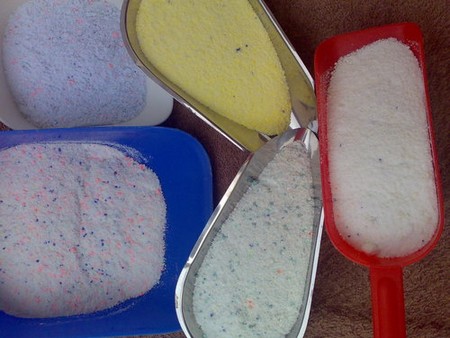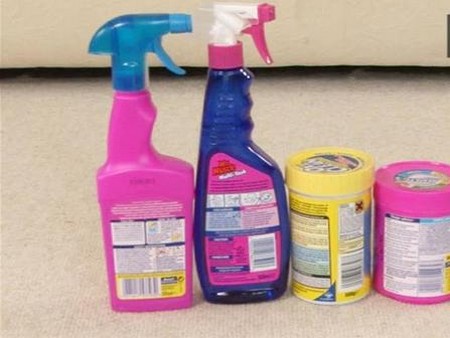There is such a wide range of both washing materials and fabrics available on the market that it can be confusing. To complicate matters further several entirely new ranges of environmentally (and physically) safe products are appearing on the market. If these are available to you, use them, otherwise follow the guide below. Always read any instructions given on the item you wish to wash, as well as those on the product and on your washing machine.
Washing powders
Washing powders can be either soap powders, synthetic detergent powders or a blend of the two. Some are best for hard-water areas and some for soft water. They are used for normal machine-washing, although some have less lather than others so are better in certain types of washing machine. Read the washing powder packet and your washing machine manual for further information.

Many washing powders work better in hot water which is a waste of energy. Many contain a number of pollutants which can also cause eczema and other skin problems. Use environmentally safe products when available. If you must use detergents, experiment by using less than the recommended amount. Soap powders are less effective in hard-water areas, so it is better to use synthetic detergent powders than to add more soap powder. Add water softener to your wash for more effective cleaning rather than extra detergent.
Biological (enzyme) detergents
These are designed for removing protein stains, such as blood, eggs, fruit, etc that cannot be removed by other washing powders. The enzymes work by breaking down proteins. They can be used for soaking items and they can also be used for washing, although the enzymes become ineffective at temperatures higher than 60°C.
Soap-flakes
These produce a lot of foam which is excellent for hand-washing lightly-soiled articles, woollens and other delicate fabrics, especially in soft-water areas. For hard-water areas use synthetic detergent flakes/liquid. Do not use soap-flakes for machine-washing as they produce too much foam.
Bleach
Soaking white fabrics for an hour in a bucket of cold water to which a tablespoon of bleach has been added can make them noticeably whiter. Always read manufacturers’ instructions before using bleach and use with care. A mild solution of hydrogen peroxide is safer than chlorine-based bleaches, which can damage or destroy silk, wool, leather, rayon, elastane and resin-treated fabrics, as well as cottons with special finishes. Never use undiluted bleach and always rinse well after use.
Fabric conditioner
Fabric conditioner (or softener) is added to the final rinse and its effect lasts only until the next wash. It works by coating fibres with a material which makes them feel soft. It also reduces the static electricity that causes man-made fibres to cling. Fabric conditioners contain enzymes that can be harmful to, or may irritate, some skin, especially that of babies. Never use fabric conditioner neat and make sure detergent is completely removed from the item before you apply the fabric conditioner or a chemical reaction is produced which reduces the effect of the conditioner. For a natural softness that will irritate no one, hang washing outside to dry.
Starch
Sprays or powders applied before ironing will stiffen cotton or linen fabrics.
Choosing a washing machine and drier
There are two main types of washing machine; semi- and fully automatic. Twin-tubs are semi-automatic which means they are cheaper but that you have to work a lot harder. Both the wash tub and spin drier are loaded from the top and are useful for people with small washes as they do not take large loads or very bulky items.
Fully automatic machines are usually large enough to take a family wash and some of them incorporate tumble driers. Front-loading automatic machines are the most expensive, but all you have to do is select the programme. Top-loading machines will carry out all the same washing processes but you have to change the controls from one cycle of the wash to the next.

Wringers can be bought both freestanding or attached to a washing machine and are either hand-operated or electrical. They do not get clothes dry enough for ironing.
A spin drier will remove excess water from items and speed up drying. Some spin driers will rinse as well.
Tumble driers are expensive to run but they can make ironing easier by reducing the wrinkling of clothes. Do not install a tumble drier in a room where ventilation is a problem as they generate a lot of moisture, or else choose a model with a moisture-collecting chamber. Do not overload your tumble drier and remember to remove any fluff from the filter after use.
Electric drying racks are useful for drying clothes in wet weather or if you have nowhere outdoors to hang them. They are unsuitable for clothes that should not be placed near direct heat.